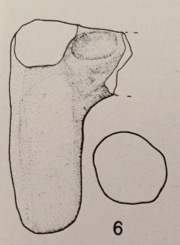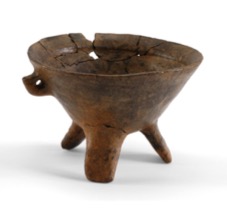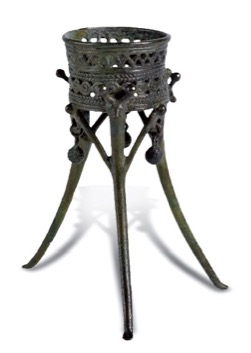Foot of a multi-foot vase (Thomes)
Among the clay artefacts found when excavating the giants’ tomb of Thomes which are on display in the Archaeological Museum of Dorgali, there is a foot fragment of a tripod vessel, alias a polypod (multi-foot) vase. There is only one cylindrical shaped foot left of the vessel (dimensions: 10.3 cm height; max. diameter 3.7 cm), with straight ends, and a piece of the joint to which the unidentifiable body was attached (figs. 1, 2).


The vessel to which it belongs was shaped by hand using a totally non-purified clay, with a coarse mixture containing many foreign bodies; the surface is reddish-brown. In order to level out the outer surface of the vessel, it was smoothed before being fired.
Tripod pots correspond to a ceramic type of various dimensions which allows cooking food in direct contact with fire.
In different shapes, they were common throughout almost all prehistoric Sardinian cultures, from the Neolithic Age up until the Middle Bronze Age to then disappear during the subsequent periods (figs. 3, 4).


This vessel shape disappears during the early centuries of the second millennium B.C., during the Middle Bronze Age. Some feet of the wide ribbon tripod vessel type, whose vase shape is so far unknown, were attributed to a type of pottery belonging to a culture of the early Middle Bronze Age in Sardinia called Sa Turricula (1600-1500 B.C.), the dating of the archaeological context unearthed in the giants’ tomb of Thomes. This particular type of foot profile is similar to those of the tripod pots used during the Culture of the Copper Age in Sardinia called Monte Claro (2400-2100 B.C.).
Miniature bronze tripods were offered during sacred ceremonies in the Nuraghic civilisation, during the Late Bronze Age (XII-IX centuries B.C.) (fig. 4).

Bibliografia
- MANUNZA M. R., La ceramica prenuragica e nuragica, in Ceramiche. Storia, linguaggio e prospettive in Sardegna, Nuoro 2007, pp. 13-47.
- MANUNZA M. R., Corredi funerari dell’Età del Bronzo Antico dal Sulcis e da altri contesti inediti della Sardegna meridionale, in Quaderni, Soprintendenza per i Beni archeologici per le province di Cagliari e Oristano, 25, Cagliari 2014, pp. 57-65.
- PULACCHINI D., Il museo archeologico di Dorgali, Sardegna Archeologica. Guide e itinerari, 27, Sassari 1998, p. 17.

 VR
VR